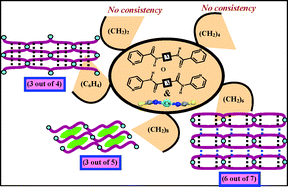The reactions of bis(3-pyridylcarboxamido)alkanes (amides, 1) and bis(3-pyridyl)alkanediamides (reverse amides, 2) with Cu(SCN)2 in the presence of various guests afforded 22 crystalline complexes containing 1D and 2D coordination networks with or without guest inclusion. In these complexes, the ratio of metal to ligand is either 1 : 1 or 1 : 2, despite carrying out all the reactions by taking metal and ligand in 1 : 2 ratio. The recognition of coordination networks via amide-to-amide hydrogen bonds in the form of β-sheet was observed in the complexes containing metal to ligand ratio (1 : 2). Various guest molecules such as DMF, nitrobenzene, benzonitrile, 1,4-dihalobenzenes, phenanthrene, biphenyl, anthracene, 9-anthraldehyde and pyrene were found to include in these networks depending on the lengths of the spacers in 1 or 2. The ligands 1 or 2 with shorter spacers such as –(CH2)2– and –(CH2)4– have shown no consistency or preference to any particular network geometry. However the ligands with longer spacers such as –(CH2)6–, –(CH2)8– or phenyl have exhibited consistency in network geometries. The iso-structurality between the coordination polymers of amides and reverse amides was observed for ligands with longer spacers such as –(CH2)6– and –(C6H4)–. The spacer –(CH2)n– found to exhibit different conformations for accommodating the guests of different sizes and shapes. The guest occupied volume in these crystal lattices varies from 27% to 60%.

You have access to this article
 Please wait while we load your content...
Something went wrong. Try again?
Please wait while we load your content...
Something went wrong. Try again?


 Please wait while we load your content...
Please wait while we load your content...